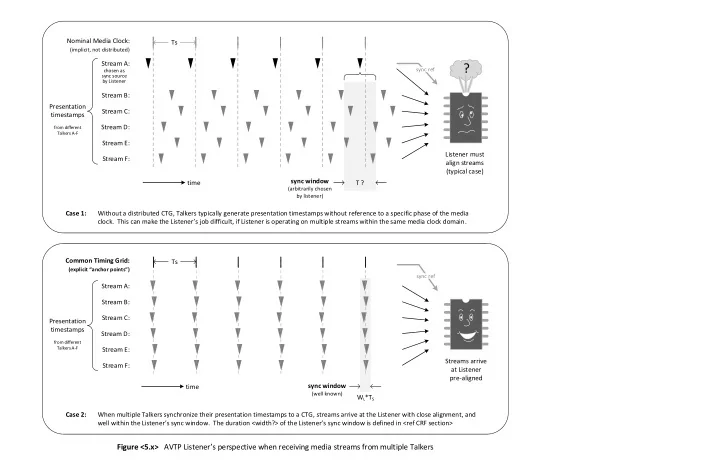

Nominal Media Clock: Ts (implicit, not distributed) Stream A: ? sync ref chosen as sync source by Listener Stream B: Presentation Stream C: timestamps Stream D: from different Talkers A-F Stream E: Listener must Stream F: align streams (typical case) sync window time T ? (arbitrarily chosen by listener) Case 1: Without a distributed CTG, Talkers typically generate presentation timestamps without reference to a specific phase of the media clock. This can make the Listener s job difficult, if Listener is operating on multiple streams within the same media clock domain. Common Timing Grid: Ts (explicit anchor points ) sync ref Stream A: Stream B: Stream C: Presentation timestamps Stream D: from different Talkers A-F Stream E: Streams arrive Stream F: at Listener pre-aligned sync window time (well known) W L *T S Case 2: When multiple Talkers synchronize their presentation timestamps to a CTG, streams arrive at the Listener with close alignment, and well within the Listener s sync window. The duration <width?> of the Listener s sync window is defined in <ref CRF section> Figure <5.x> AVTP Listener s perspective when receiving media streams from multiple Talkers
Comments on current timing measurement planes diagram in 1722-2011 Question: Is this diagram due for changes or replacement? (not sure.. Discuss..) Application dependent and out of scope of this standard If CTG is used, must be time aligned with the CTG within a specified window of tolerance (ref CRF section of 1722a) This implies specifics about implementation (i.e. how stream packets are generated prior to going on the wire) which arguably should be out of scope Suggested Change A Talker shall queue each 1722 stream packet for transmission at a time no later than (PT – MTT), where PT is the presentation time in the current packet and MTT is the Max Transit Time.
Possible new diagram to help more cleary define and quantify the presentation time offset concept and requirement Time-sensitive Time-sensitive Time-sensitive Application A Application B Application C t G.A t P.A t G.B t P.B t G.C t P.C AVTP AVTP AVTP AVTP AVTP AVTP Talker Listener Talker Listener Talker Listener AVB/TSN AVB/TSN AVB/TSN t GQ.A t QP.A t GQ.B t QP.B t GQ.C t QP.C compliant compliant compliant Network Network Network Interface Interface Interface Tx Rx Tx Rx Tx Rx queue queue queue queue queue queue Phy Phy Phy t MT.CB t MT.CA t MT.BA t MT.BC t MT.AB t MT.AC Network Infrastructure Stream AC Example: Calculation of minimum Presentation Time Offset for Stream AC PTO AC t GQ.A + t MT.AC + t QL.C where: t GQ.A = time from sample generated to packet in tx queue for Talker A t MT.AC = max transit time across network from Talker A to Listener C t QL.C = time from rx queue to ready for app consumption for Listener C
Recommend
More recommend